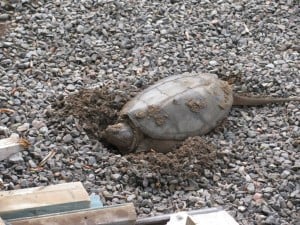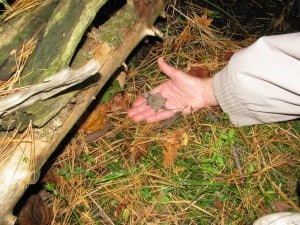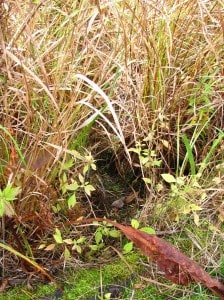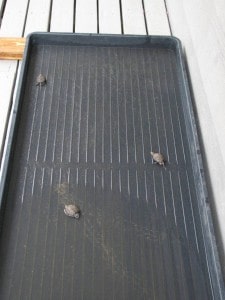Earlier this year, on June 17, we witnessed a Snapping Turtle laying her eggs in our gravel turning circle. We protected the area with wire mesh weighted down at the edges. We had first indications of hatching when a small hole appeared 16 weeks later. Between October 8th-14th, we recorded 20 hatchlings. Of those, 17 were all carried down to the river by an anxious guardian – me. We did come across three dead turtles at some distance from the nest, at least one of which may have hatched earlier, and these appeared to have been heading the wrong way in the opposite direction from the river, as did some of the remaining turtles when they emerged from their nest. I do so hope our intervention with the 17 gave them a chance and that some of them manage to survive, despite their natural instinct to crawl away westward not eastward towards the river.
For the last three hatchlings, Peter and I put them in a “holding bed” (a large tray with some water at one end) as a nursery, as these last three still had not absorbed their sacks. We took the tray up onto the porch to keep the little ones safe from predators. Despite a stay of over 4 hours in the nursery, only one had absorbed the sack, but they were all so eager in trying to climb out of the tray and regularly falling backwards onto their backs, that we thought it wise to take them to the river. I put them onto a smooth short walk to the shallow muddy water, in hopes that the sacks wouldn’t rupture on this smooth surface.
In the past, the turtles we have rescued have all become very animated in my hand as I walked down towards the river, moving from hand to hand as they sensed the proximity of water. These little ones, for the most part, were rather passive and only a few reacted as I drew near the river.
I did phone the Ontario Turtle Conservation Centre for some advice about the sacks and the “holding bed” and was assured I was doing the right thing. However, she too was puzzled by the direction the turtles were taking after hatching. As she said, nature isn’t perfect and there are so many factors affecting the development of the turtles in their eggs. Some may not have been fully fertilized, temperatures may have affected them, etc. She did say that the eggs tend to hatch over a few days, not taking as long as our lot. In the end there remained four eggs unhatched in the nest. Peter back-filled the hole for the winter, but I don’t suppose these few will hatch next year.
I’ve attached a picture of Mom laying the eggs, and two of the turtles on their arrival at the river and a couple of the nursery pictures. It was wonderful to see these little ones emerge from their underground nest and view the world for the first time.
Stephenie Armstrong, Sawmill Road, Warsaw



